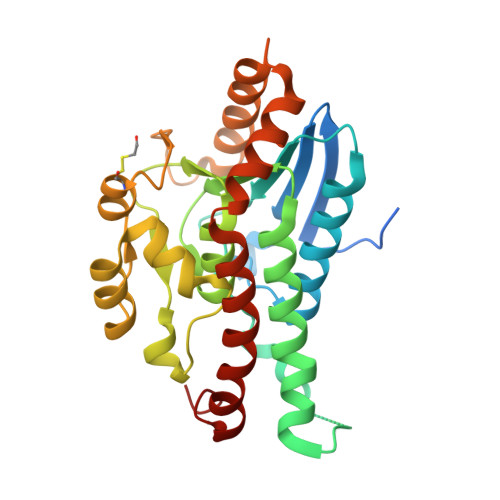Structures of yeast peroxisomal Delta (3), Delta (2)-enoyl-CoA isomerase complexed with acyl-CoA substrate analogues: the importance of hydrogen-bond networks for the reactivity of the catalytic base and the oxyanion hole.
Onwukwe, G.U., Koski, M.K., Pihko, P., Schmitz, W., Wierenga, R.K.(2015) Acta Crystallogr D Biol Crystallogr 71: 2178-2191
- PubMed: 26527136
- DOI: https://doi.org/10.1107/S139900471501559X
- Primary Citation of Related Structures:
4ZDB, 4ZDC, 4ZDD, 4ZDE, 4ZDF - PubMed Abstract:
Δ(3),Δ(2)-Enoyl-CoA isomerases (ECIs) catalyze the shift of a double bond from 3Z- or 3E-enoyl-CoA to 2E-enoyl-CoA. ECIs are members of the crotonase superfamily. The crotonase framework is used by many enzymes to catalyze a wide range of reactions on acyl-CoA thioesters. The thioester O atom is bound in a conserved oxyanion hole. Here, the mode of binding of acyl-CoA substrate analogues to peroxisomal Saccharomyces cerevisiae ECI (ScECI2) is described. The best defined part of the bound acyl-CoA molecules is the 3',5'-diphosphate-adenosine moiety, which interacts with residues of loop 1 and loop 2, whereas the pantetheine part is the least well defined. The catalytic base, Glu158, is hydrogen-bonded to the Asn101 side chain and is further hydrogen-bonded to the side chain of Arg100 in the apo structure. Arg100 is completely buried in the apo structure and a conformational change of the Arg100 side chain appears to be important for substrate binding and catalysis. The oxyanion hole is formed by the NH groups of Ala70 (loop 2) and Leu126 (helix 3). The O atoms of the corresponding peptide units, Gly69 O and Gly125 O, are both part of extensive hydrogen-bond networks. These hydrogen-bond networks are a conserved feature of the crotonase oxyanion hole and their importance for catalysis is discussed.
- Biocenter Oulu and Faculty of Biochemistry and Molecular Medicine, University of Oulu, Oulu, Finland.
Organizational Affiliation:


















